Building codes are considered living documents, which means they evolve with time. The International Code Council, for example, operates on a three-year cycle. The most current edition of all the ICC family of codes is the 2021 version. Model codes such as the International Building Code and the International Residential Code have the same date, which is 2021. During that three-year cycle, modifications to the code are debated in a public forum and possibly voted into acceptance. The public forums are now complete for the 2024 editions. Model codes are then accepted and adopted, possibly with amendments by local jurisdictions.
Public forum hearings are an excellent source for predicting what will be required by local jurisdictions in the future. Another source is to monitor the standards development process. Building codes establish regulations by referencing applicable standards. Acceptance of a building product and its application is most often accomplished by compliance to the appropriate standard. For example, to be compliant to the code, nonstructural cold-formed steel products must comply with the Standard AISI S220, North American Standard for Cold-Formed Steel Framing – Nonstructural Members. Installation of those framing members should comply with ASTM C754, Standard Specification for Installation of Steel Framing Members to Receive Screw-Attached Gypsum Panel Products. Hence there is a direct link between standards, codes and, therefore, local compliance.
One recent code change that impacts contractors nationwide who work with exterior cement plaster. The change is that a rainscreen system must be included when the plaster is applied over wood-based sheathing. AWCI recently published a technical paper that outlines the specifics to this change and is available from the AWCI website.
In the future, this rainscreen concept will likely encompass more claddings, not just cement plaster. The contractor will require an understanding of building science and code provisions that are driving this change. It will also necessitate mastering the sequencing of this change. It might offer the opportunity for added scope of work and recognition for the contractor who exhibits expertise in rainscreen systems.
Of potential benefit to contractors is helpful information when there is disagreement with an owner or architect on perceived aesthetics. The intent is to provide information when certain claddings, cement plaster and EIFS are subjected to what is called “critical lighting.” Language is being drafted through the standards development process that should manage expectations of the finished installation. The intent is to provide clarification when an architect or owner expects a machined precision installation from a cladding that is applied by craft.
Contractors should benefit by the goal to align the similar standards published by both ASTM and the Gypsum Association. The two standards are GA 216, Application and Finishing of Gypsum Panel Products and ASTM C840, Standard Specification for the Application and Finishing of Gypsum Board. The standards run parallel paths and are both referenced in the model codes, but there were subtle differences between them. The ASTM standard is undergoing a major update to be more in line with the GA document. This will minimize the differences that lead to confusion in interpretation.
In 2021 the ICC announced it was changing the established framework for future development of the International Energy Conservation Code. It will now follow a more of a standards-type process. The potential outcome could be provisions that are more theoretically driven, and conceivably change the way that exterior envelopes are designed and installed. The IECC is working to further reduce energy consumption and greenhouse gas emission by tightening up air leakage and thermal transmission requirements.
At the recent meetings of the AWCI Construction Technology Council, Michael Gardner of M. Gardner Services gave a talk on what he sees as emerging trends in the codes and standards arena. One change that is coming is the result of the recently passed federal act. Gardner stated the following: “The Inflation Reduction Act passed by Congress in the fall (2022) contained funding to encourage jurisdictions to update local building codes. Contractors should, as a result, monitor activity that might suggest an update of the edition of the model code being enforced by a jurisdiction is forthcoming. Surprisingly, some communities enforce a significantly outdated code or no building code whatsoever. The IRA is intended to rectify either situation as several studies have shown that updated codes reflect building technologies that save lives and mitigate damage from natural disasters.”
These are all examples of the fact that the only constant in construction is change. The successful contractor must be aware of ever-evolving code and standards, and be resilient to adapt with a goal of excelling in their market.
Robert Grupe is AWCI’s director of technical services.



